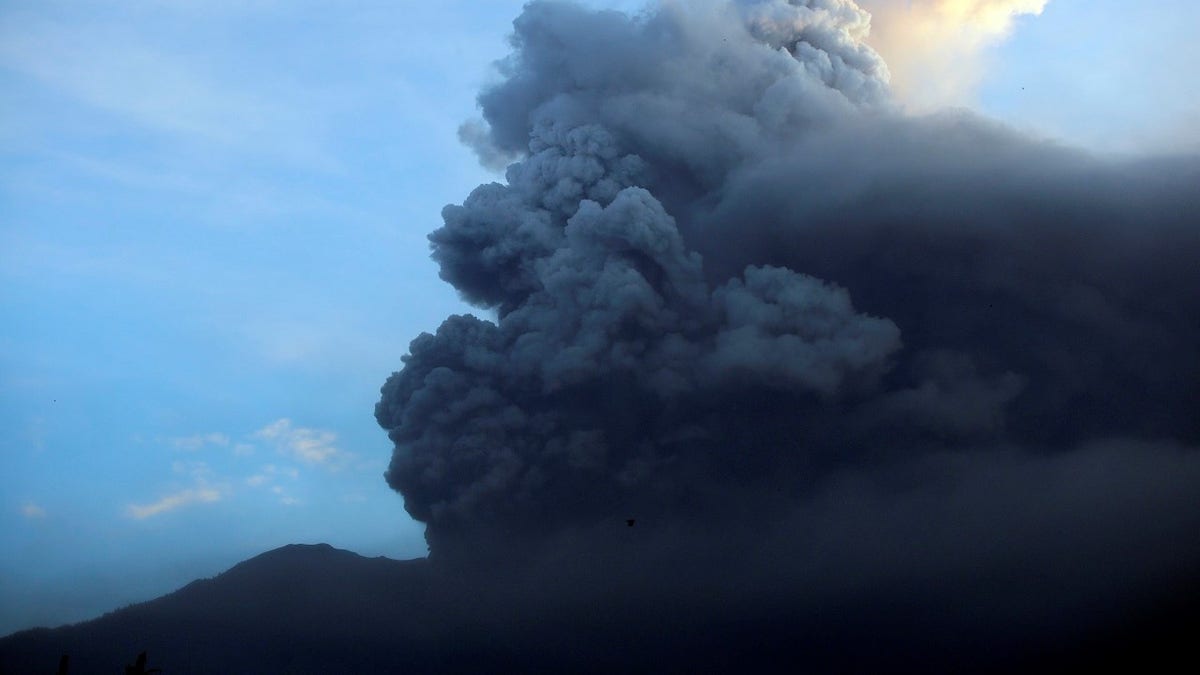
A view of the Mount Agung volcano erupting at sunrise in Karangasem, Bali island, Indonesia, Sunday, Nov. 26, 2017. A volcano on the Indonesian tourist island of Bali erupted for the second time in a week on Saturday, disrupting international flights even as authorities said the island remains safe. (AP Photo/Firdia Lisnawati) (Copyright 2017 The Associated Press. All rights reserved.)
After a rumbling volcano on the Indonesian tourist island of Bali erupted several times over the weekend, authorities raised the alert to the highest level on Monday and closed the international airport, stranding thousands of travelers.
Emitting thick plumes of smoke, Mount Agung has been hurling ash thousands of miles into the atmosphere since Saturday, which had already forced the small international airport on the neighboring island of Lombok to close as the plumes drifted east.
The National Disaster Mitigation Agency said Bali’s international airport, where most flights had been continuing, was closed for 24 hours. It said authorities would consider reopening it Tuesday after evaluating the situation.
Video showed passengers on the tarmac at Bali’s airport checking their phones and chatting.
Geological agency head, Kasbani, who goes by one name, said the alert level was raised at 6 a.m. because the volcano has shifted from steam-based eruptions to magmatic eruptions. However he says he’s still not expecting a major eruption.
“We don’t expect a big eruption but we have to stay alert and anticipate,” he said.
The exclusion zone around the crater was widened to six miles. Previously it ranged between 3.7 to 4.7 miles.
Ash up to less than half an inch thick has settled on villages around the volcano and soldiers and police distributed masks over the weekend.
Agung’s alert status was raised to the highest level in September following a dramatic increase in tremors from the volcano, which doubled the exclusion zone around the crater and prompted more than 140,000 people to leave the area. Many residents returned home after the alert was lowered on Oct. 29 after a decrease in activity, but about 25,000 residents are still in temporary shelters, Fox News previously reported.
A possible major eruption has deterred many travelers from visiting Indonesia’s top tourist destination. More than 5 million visitors a year travel to Bali for its Hindu culture, surf beaches and lush green interior. Nearby Lombok is relatively undeveloped as a tourist destination, receiving fewer than 100,000 international visitors a year. However, Bali has lost at least $110 million in tourism after major evacuations were ordered in September, the BBC reported.
Agung also had a minor eruption on Tuesday, but authorities have not raised the alert status from the second-highest level that would include more people in the exclusion area, forcing them to evacuate. Though ash from the volcano could rain down for at least another month, no major eruption is expected, government volcanologist Gede Suantika said. A red-yellow light visible in ash above the mountain was the reflection of lava in the crater.
Indonesia sits on the “Pacific Ring of Fire” and has more than 120 active volcanoes. The volcano’s last major eruption, in 1963, killed about 1,100 people.
The Associated Press contributed to this report.
